Watching his step, Paul Stafford searches for the white rat as he navigates one of India’s – and Hinduism’s – more unusual religious sites. Devoted to hordes of living, scurrying rats, Karni Mata temple in Rajasthan is certainly not for the squeamish.

The face of a thirsty God (Photo: Axel Drainville via Flickr)
Bouncing over dusty roads, the rickety bus pulled to a stop outside a modest looking Hindu Temple in Deshnoke, Rajasthan. The sun was high and the streets were relatively empty, at least by Indian standards. The arid Thar Desert makes its presence known wherever you go in these parts. A withered cow plodded along beside the pink walls and lowered its head to the ground. It was difficult to tell if it was sniffing at something or listening intently, for inside those walls were thousands of rats.
After passing through a security gate and removing my shoes – something I was reluctant to do given the circumstances – I wandered towards the delicately wrought main gateway. Intricate patterns and religious iconography were rendered in marble. Gods and pachyderms. Pigeons, the rats of the sky, perched atop any available flat ledge. The closer you looked the more you could see, slotted into crevices, like an optical illusion.
I raised my camera and took a snap. Somebody patted me on the shoulder. Had I been insensitive already? I turned and saw a young man with greasy black hair pointing to a sign. You had to pay more for the privilege of taking photos. I’d already paid an elevated fee at the entrance on account of being a foreigner. Now the sacred sanctity of this holy place was up for sale too. At least there was an open honesty about the discrimination here. I supposed it was only fair that India asked for a little something in return, what with the sins of the Empire and all that. And anyway, who wouldn’t want to push the boat out when it came to seeing heaps of rats?
Passing into the main temple area I saw my first rodent. It was somewhat underwhelming. I’d read that there were thousands of them scurrying around the temple, but in the main courtyard there was only one. It was causing a great deal of mirth among a group of young girls in brightly coloured saris. The rat changed direction rapidly and ran straight over the foot of a girl in red. India’s very own bull fight in miniature. She screamed and her friends ran away.
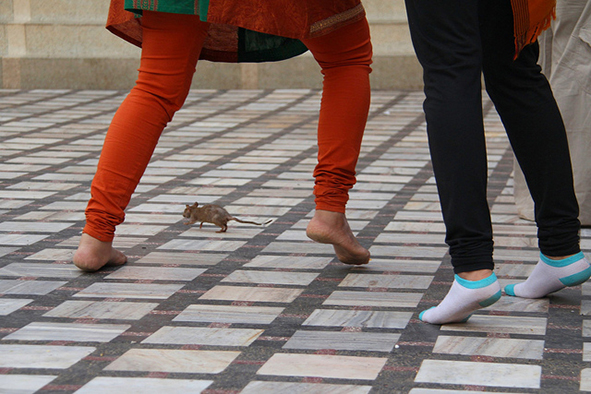
Dancing with the Gods (Photo: Arjun via Flickr)
White rats
This rat in the courtyard was a scruffy brown colour. Supposedly there are a couple of albino rats in the temple. To see one is considered an auspicious sign. Even white rats were put up on a pedestal. I looked around not seeing any rats at all, and certainly not seeing a white rat.
A number of people were crammed into a shrine that was off limits to non-Hindus. This was where they came to pay their respects to their rat Gods. Peeking inside I noticed the Gods themselves, as though my eyes were growing accustomed to a dark room. They were all around me in fact, hidden in plain sight, mostly huddled in groups and in the shade, away from open areas.
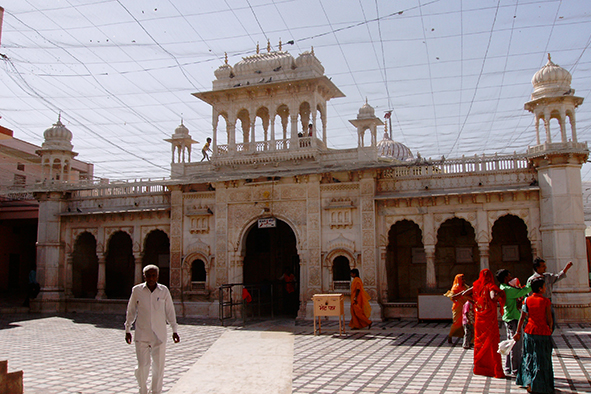
Netting keeps out godless predators (Photo: Paul Stafford)
It may seem somewhat whimsical or even a little eccentric, but the worship of rodents finds its root in classic Hindu story telling. Legend has it that Karni Mata, a Hindu warrior sage, saw her stepson drowned in a pond. Another version of the story has it that it was the son of a local story teller who drowned. Either way, Karni Mata then entreated Laxman, the God of Death, to revive the boy. There’s always some sort of Hindu caveat; in this case it was that he was brought back, but as a rat. Thus he had a temple built to honour him and his return from the dead. He was joined through the years by either Karni Mata’s sons or every story teller who ever died in that town, depending on which story you believe.
I preferred the story teller angle. Something about it seemed so meta, like the creators of religious folklore honouring themselves. I looked down as something brushed by my foot. I resolved myself not to move or react. The little fellow soon got bored and scuttled away. Clearly that was one story he was not going to be telling his fellow furry brethren.
Following the rat, I came to a stainless steel bowl filled with milk. Rats lined the edges lapping up the offering. Nearby, a bowl of grain was receiving a little less attention. I’d stumbled into some sort of annex of the temple. The polished marble had given way to a series of rooms that looked like disused sand silos. They were dirty and littered with bits of debris. I assumed this was how the rats liked it. “Hey Sandro, wanna hit the sand pit or the grain room this evening?” I imagined they’d say. “Neither for me thanks, I’ve an anointment at 7, then Bill’s telling us the story about the time he was a human near the elephant carving.”
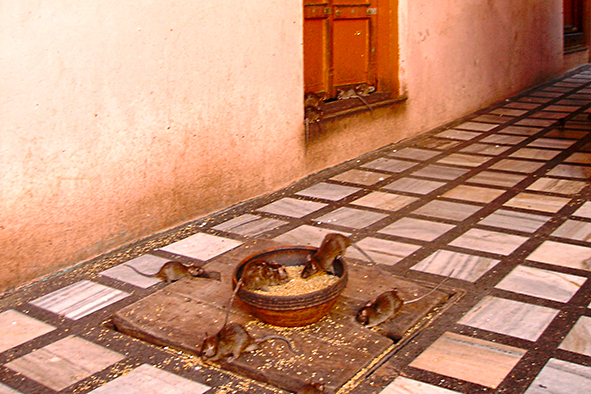
Snacking on grain in the corridor (Photo: Paul Stafford)
Where Rat Gods Fit into the World’s Oldest Religion
Hinduism is often described as being more like a pagan-style collection of beliefs, rather than an organized religion. While that may seem like a simplified description to many, exploring its complexity would require a separate, much longer article.
“But hang on a minute”, you say, “haven’t pagans been known to kill rats in the past?” Well, all sorts of groups have killed rats for all sorts of reasons; health, spiritual or otherwise. There are, of course many shared beliefs and values across Hinduism, but people are free to worship whichever deity they please for many reasons, including family and community. While Hinduism is considered to be polytheistic, each of the many Gods is considered to represent a part of the whole, an overarching, universal God, and so it is essentially pantheistic. And that’s where our lovely rats scuttle back into the fray.
Being representative of part of a whole universe, one of the rat deities decided to eat its dead friend. This cannibalistic tendency was news to me. Perhaps the deification had gone to the rat’s head and he had gone mad with power? Or perhaps he was just a little furry Hannibal, given free reign by the unassuming devotion of the pious. Either way, the circle of life was unfolding right in front of another rat that was lounging in between the spikes of a metal trident of sorts, his torso drooped over a small spool of metal in utter apathy.
I poked around for a little longer, searching in vain for the white rat that was supposed to make everything better. It was to no avail. Each alcove and dusty closet space offered up more regular rats, with spiritual properties, but none quite so auspicious. As I left I took one last look at the temple and wondered whether one day I, as a story teller, may end up back here on a different plane, or as a different incarnation.
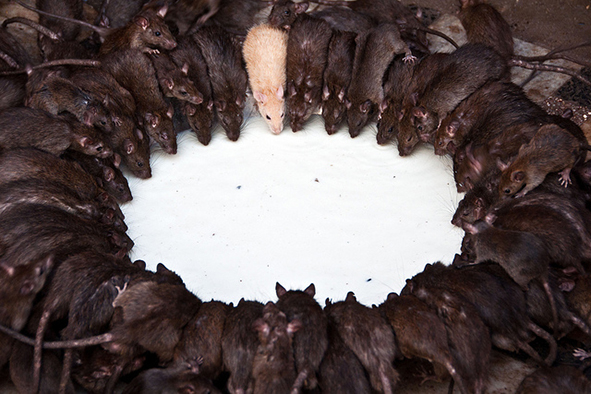
The coveted yet elusive white rat (Photo: Ingrid Truemper via Flickr)

Queuing to offer respect, or nibbles (Photo: Paul Stafford)
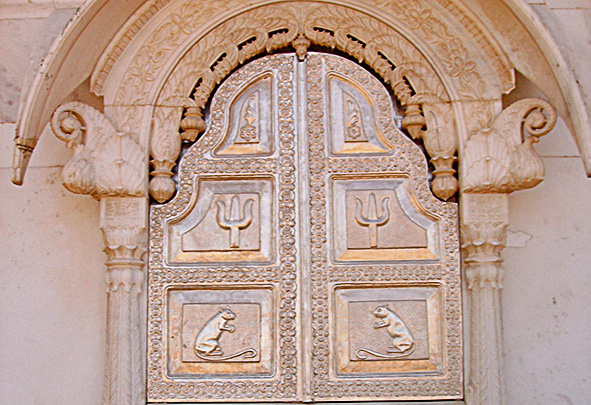
Silver rat doors (Photo: Paul Stafford)